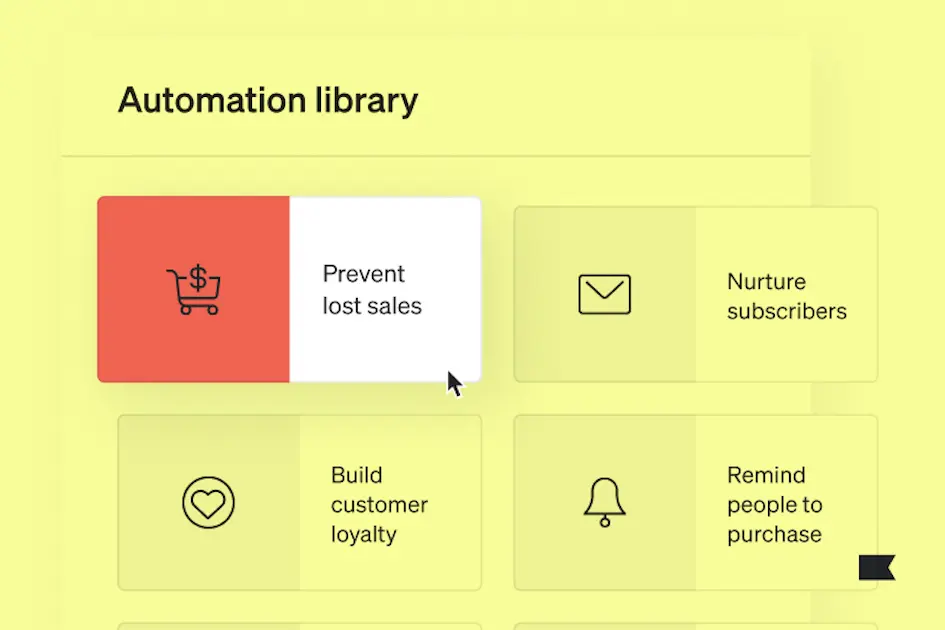Guide to welcome email flows: tactics and examples to nurture new subscribers
Email marketing yields a 122% ROI on average. Within that, welcome email automations earn 4x the click rate and 23x the conversion rate of regular marketing emails.
In today’s volatile economic climate, investing in email marketing—and specifically a welcome email flow—is a smart move.
Table of contents:
- What is a welcome email flow?
- The 4 main types of welcome email
- 6 elements of a successful welcome email
- How to build a welcome email flow
- How to automate your welcome emails
- How to enhance your welcome email flow with data
- Welcome email FAQs
What is a welcome email flow?
A welcome email flow or series is a sequence of automated emails sent to new subscribers after they sign up to join your list. Welcome emails introduce people to your brand after they’ve signalled interest and are a great opportunity to establish credibility and build trust, introduce products, and gather more information on subscribers.
Alexa Engelhart, vice president of client strategy at Power Digital Marketing, advises brands not to underestimate the conversion power of an effective welcome email flow. “Don’t be afraid to be aggressive,” she says.
“We’ve found that most people make a purchase within 10 days of subscribing to a mailing list,” Engelhart explains. “Make sure you have emails sending throughout that 10-day window when people are most likely to purchase.”
During your welcome flow period, focus on sending emails that:
- Establish subject matter credibility and authority.
- Introduce products.
- Gather subscriber preferences.
- Encourage conversion with special offers, coupons, and discount codes.
The 4 main types of welcome email
There’s no universal “right answer” to the type of welcome email series you should send. There’s only the right answer for your audience, which you’ll figure out through A/B testing and talking to your customers.
But if you need some inspiration, here are the 4 most common types of welcome emails:
1. The educational welcome email
A welcome email is an opportunity to educate a captive audience about your products and their value. While many brands use their welcome series as a chance to tell their brand story, proceed with caution. Subscribers are thinking, “What’s in it for me?” Before talking about yourself, you need to answer this question.
Lindsey Arellano, director of email and SMS at Curio, thinks of it like this: “Brands could provide valuable content like exclusive tips or access to a helpful resource. Providing value can help establish the brand as an authority in their field and make subscribers more likely to engage with future emails.”
Health and nutrition brand Primal Kitchen does a great job straddling the line between brand story and customer value in this ecommerce welcome flow example. Their mission statement—“change the way the world eats”—is supported by what provides value to their customers: “real ingredients with integrity.”
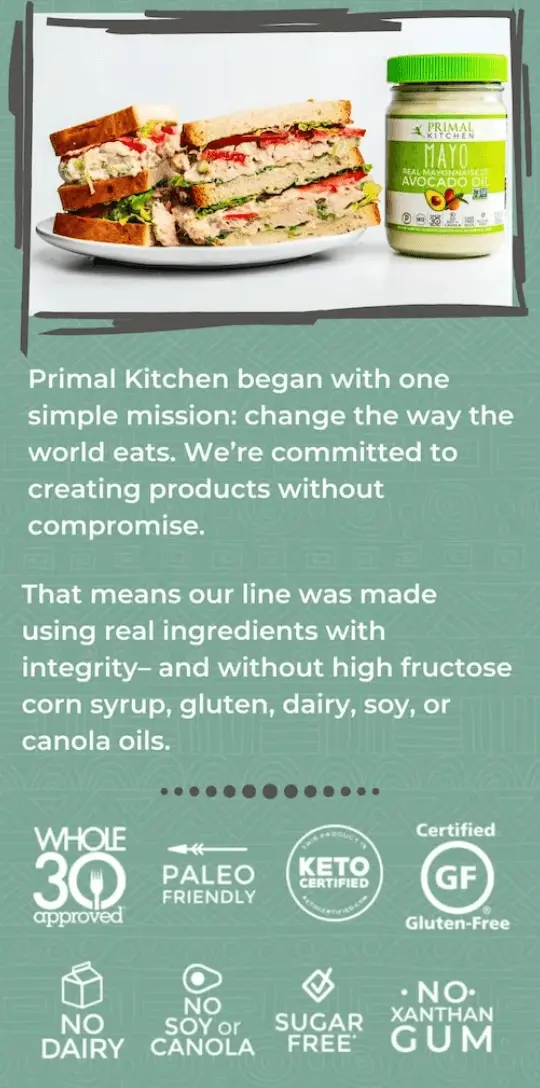
2. The offer welcome email
The first rule of welcome email flows is to send any offer you promised in exchange for a sign-up. This is how you build a foundation of trust with subscribers from the start.
If you don’t want to lead with a discount, that’s OK—your cost economics may not allow for it. But Christopher Maroney-Petitt, owner of Ecom Growers, recommends some experimentation with offers for “non-converters” further along in your welcome series, after you’ve already sent educational, tutorial-type emails.
“The best tactic I’ve implemented,” he says, “is an upgraded offer somewhere down in the welcome series flow. You do this if someone hasn’t converted already. That upgraded offer can be a better discount, free gift, giveaway entry, etc. If your other emails do a good job on educating, this upgrade will convert.”
If you want a point of reference for this type of welcome message, look no further than sneaker retailer Atoms.
This email, sent to subscribers who haven’t converted yet, is minimal, conversational, and something that feels like it’s coming from a friend rather than a brand. Send this type of email after you’ve educated subscribers with product-focused content.

3. The product-focussed welcome email
Similar to an educational email, a product-focussed email is a great way to make sure your audience knows about your brand value from the start. Your welcome series is your chance to make a good first impression, so focus on your bestsellers or use the opportunity to introduce new products.
For example, Brightland’s welcome email is divided into sections that discuss the ingredients that make each product stand out:
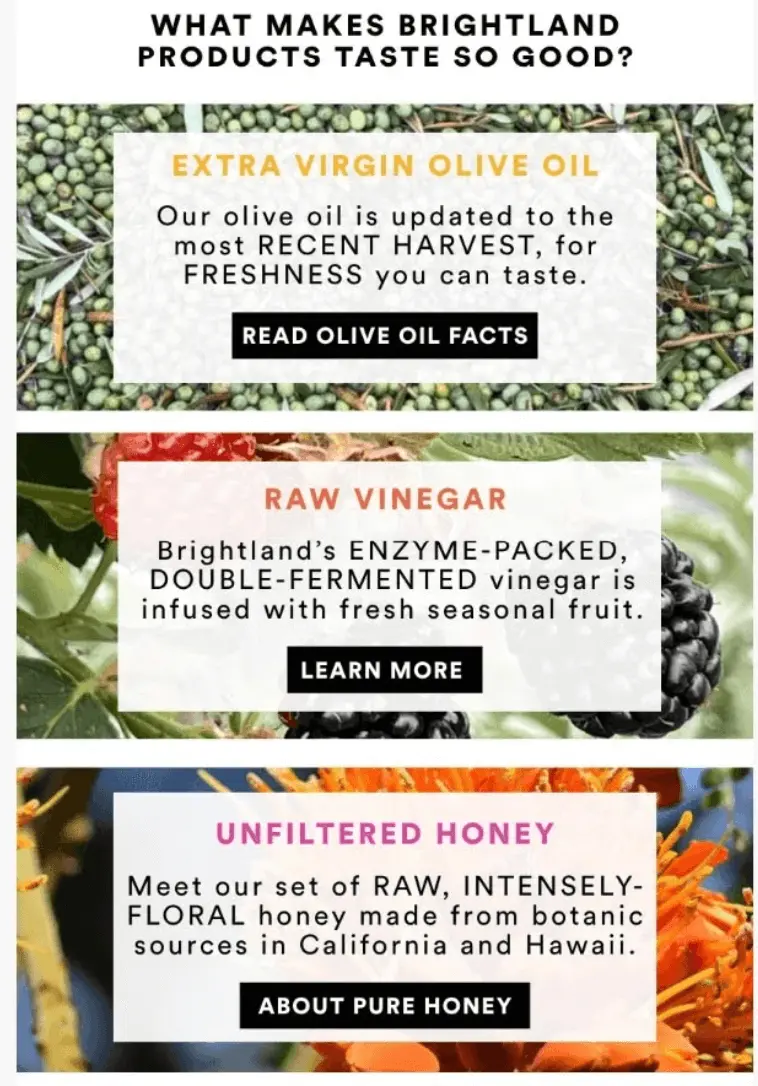
4. The information-gathering welcome email
This type of welcome email is often overlooked, but it’s important for sending more relevant emails in the long run. To give yourself the best opportunity for building long-lasting relationships with your subscribers, find out what they like and how often they want to hear from you.
Fishing brand Mystery Tackle Box gathers this information right away with their sign-up form, but you can also use a double opt-in email to accomplish the same thing (more on this later).
Here, Mystery Tackle Box promises to send subscribers “the email [they] want and nothing more,” asking whether they’re interested in the newsletter, promotions, or product updates. They also provide a lot of frequency options, so subscribers can control how often they receive emails.
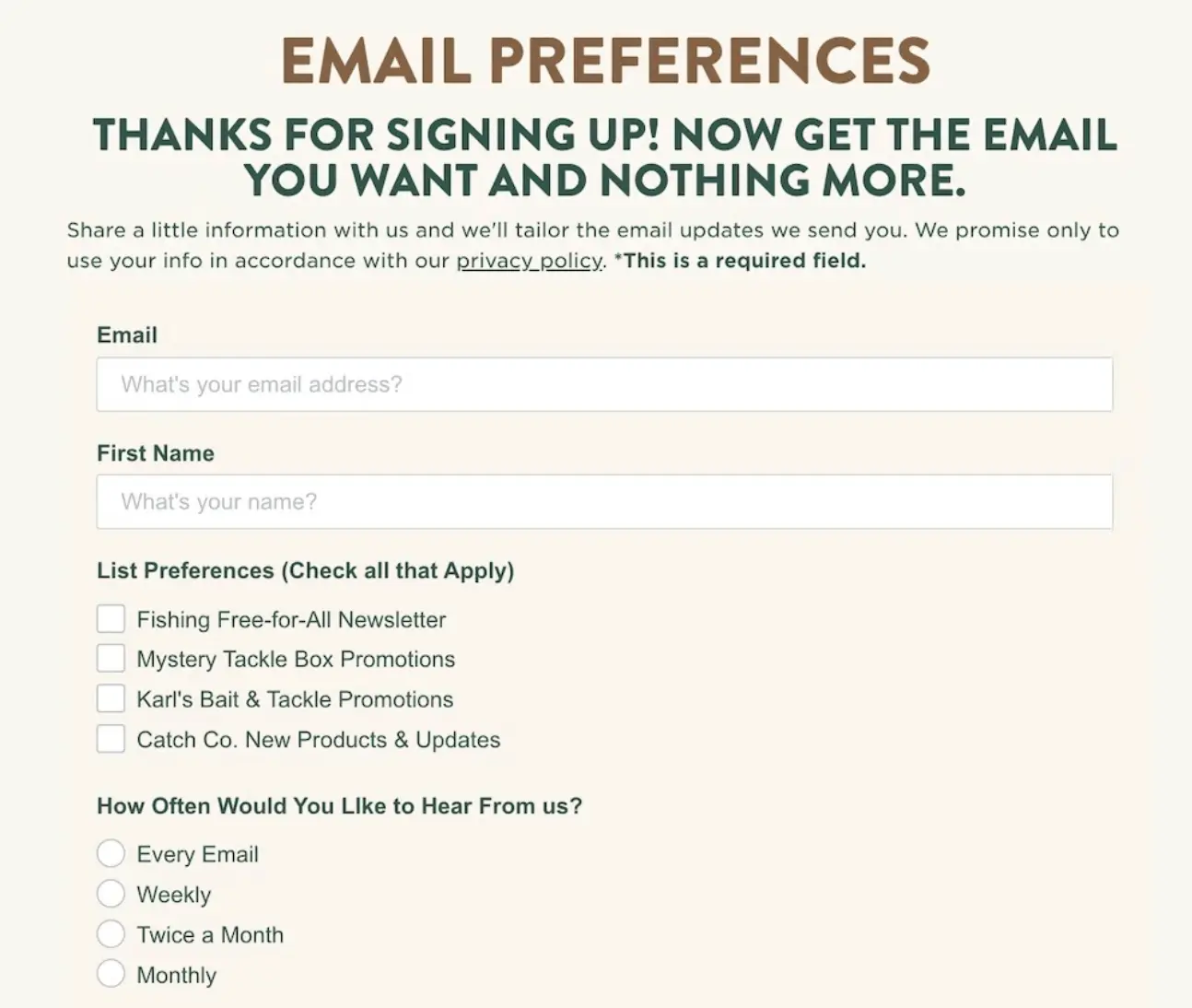
6 elements of a successful welcome email
A lot goes into a great welcome email flow. Kevin Orbach, CEO of a marketing agency with the same name, sums it up best: “Create a desired action. Nobody wants to get the introduction experience again. It’s critical to think about the customer journey as an event in a series. Include an activity, an engagement opportunity—something, anything, for the customer to continue to interact with.”
Here, we break down the components that create this interaction, from your subject line to an enticing offer you can send to new users:
1. An intriguing subject line
According to OptinMonster, 47% of email recipients decide to open an email based on its subject line. So it’s something you need to get right—and it’s both an art and a science.
To understand what makes a great subject line, Klaviyo’s business intelligence team studied more than 630K email marketing campaigns in 2022. Here’s a rundown of what we found works the best:
- Use the recipient’s first name in the subject line. Email campaigns with the recipient’s name in the subject line have an 8.92% average open rate, compared to a 8.64% open rate for subject lines without a name.
- Keep it clear and brief. Standard subject line length across all business sizes is about 7 words long (including emojis), or 36 characters.
- Evoke curiosity. Experiment with teaser-style subject lines that encourage people to open your email just to find out what’s inside.
- Use emojis sparingly. Subject lines with emojis perform slightly worse than those without them. Emojis in subject lines are also popular, so you may not be standing out as much as you think.
- Use preview text. Preview text is additional text that appears under your subject line. It’s important for providing more context, so don’t waste the real estate—put some thought into how your preview text expands on your subject line.
2. On-brand email copy
Your email copy is only as compelling as the perks you’re offering the subscriber, whether that means an actual discount or product benefits. If you can answer the question, “What’s in it for me?” for the reader, your email is well on its way to generating ROI.
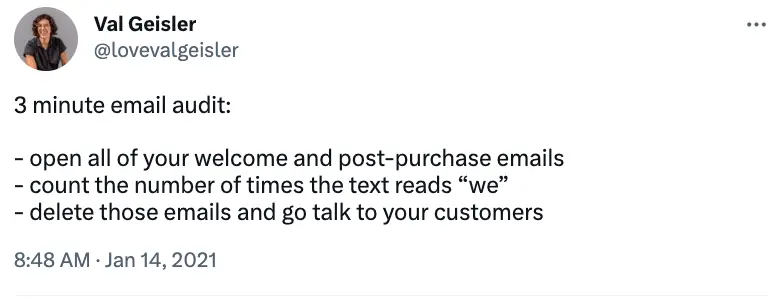
“Great copy” for a welcome flow means:
- Describing the value of your products in a compelling way
- Offering something to the recipient in exchange for subscribing
- Using social proof to build credibility and trust
For example, cookware brand Our Place builds a compelling referral engine into their welcome series.
When subscribers tell a friend about the brand, they get $20 off their next purchase—and their recommendation note to that friend acts as social proof in the email the friend receives. This referral-offer system is what makes the copy so enticing in the first place.
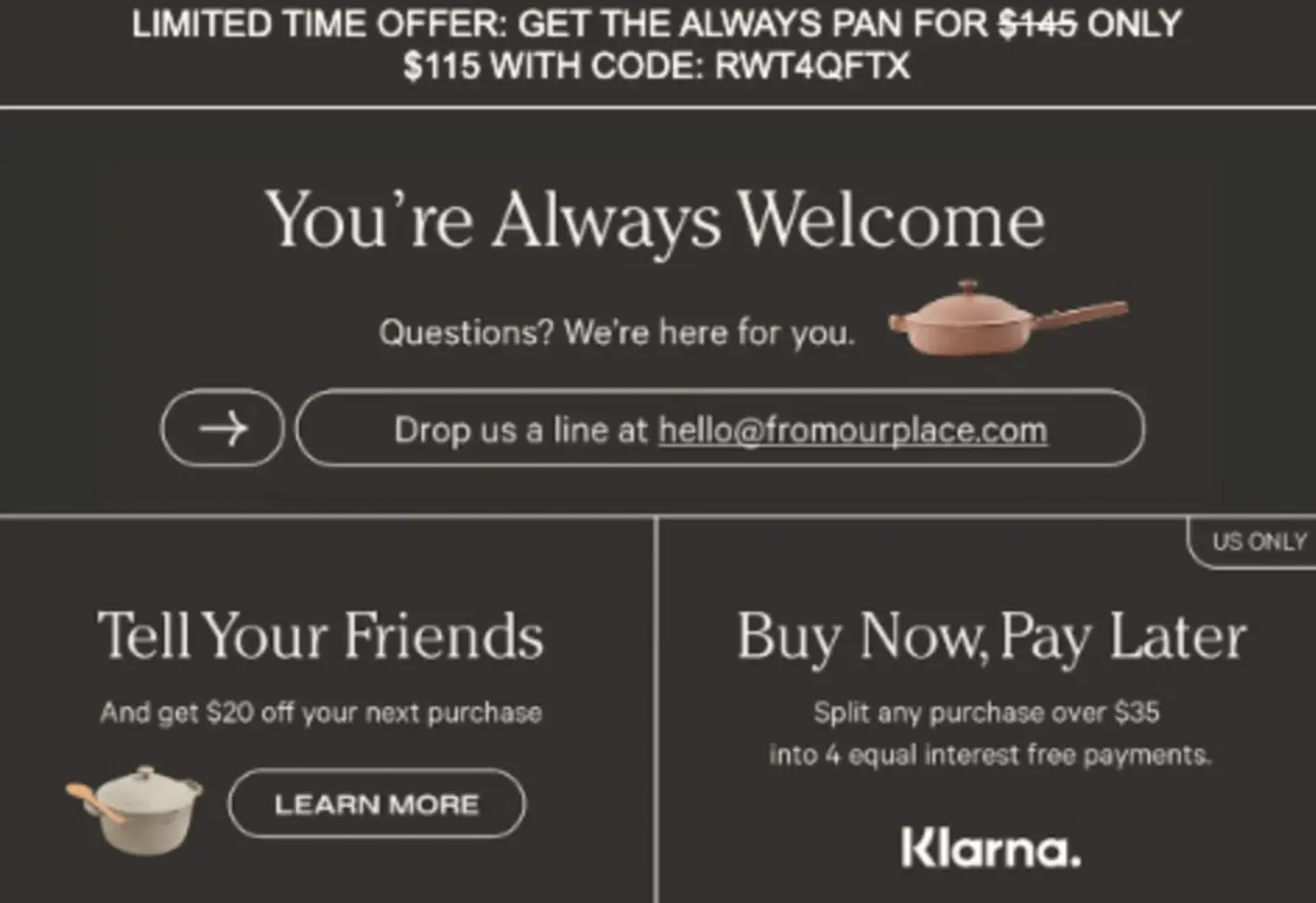
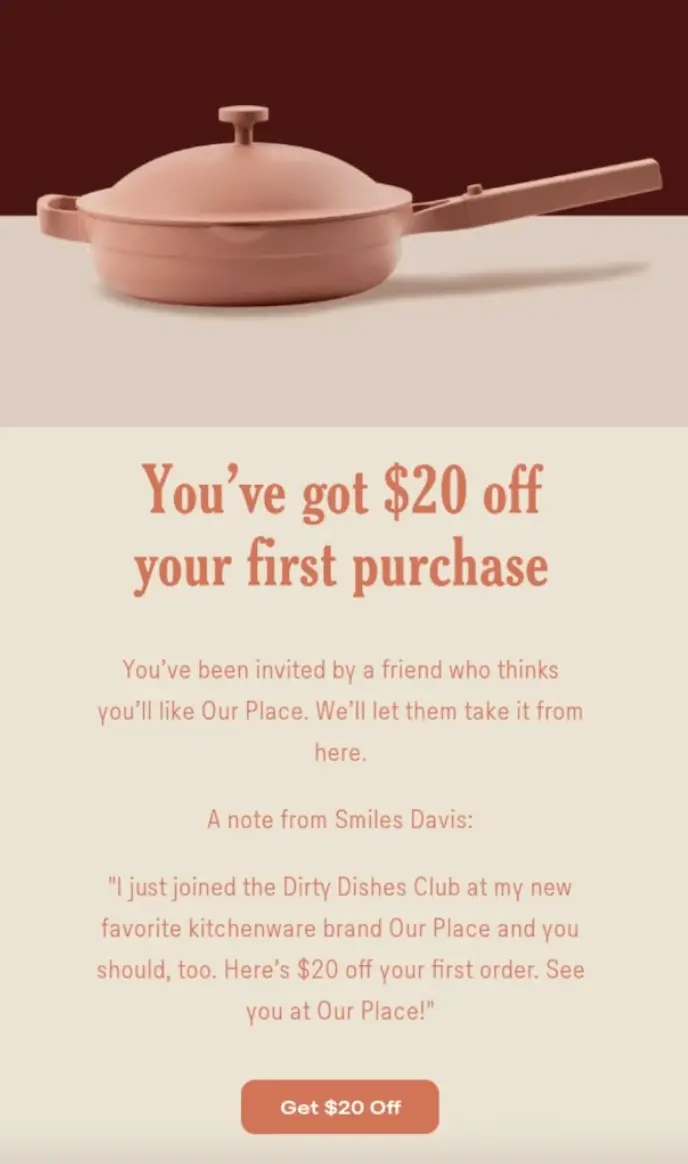
If you want to talk about your brand in your email copy, Morgan Mulloy, associate director of retention marketing at Avex Designs, advises balance.
“You want to highlight your brand and the ethos behind it,” she says, “but you don’t want to provide a lengthy biography that most won’t engage with. Bite-size information that will speak to your brand will be extremely effective.”
3. Snazzy welcome email design and video assets
Your email design depends on your goals. If your goal is to showcase your products and give readers a lot of choice, you need an image-heavy design with beautiful product shots to compel people to click. Your email may look something like this:
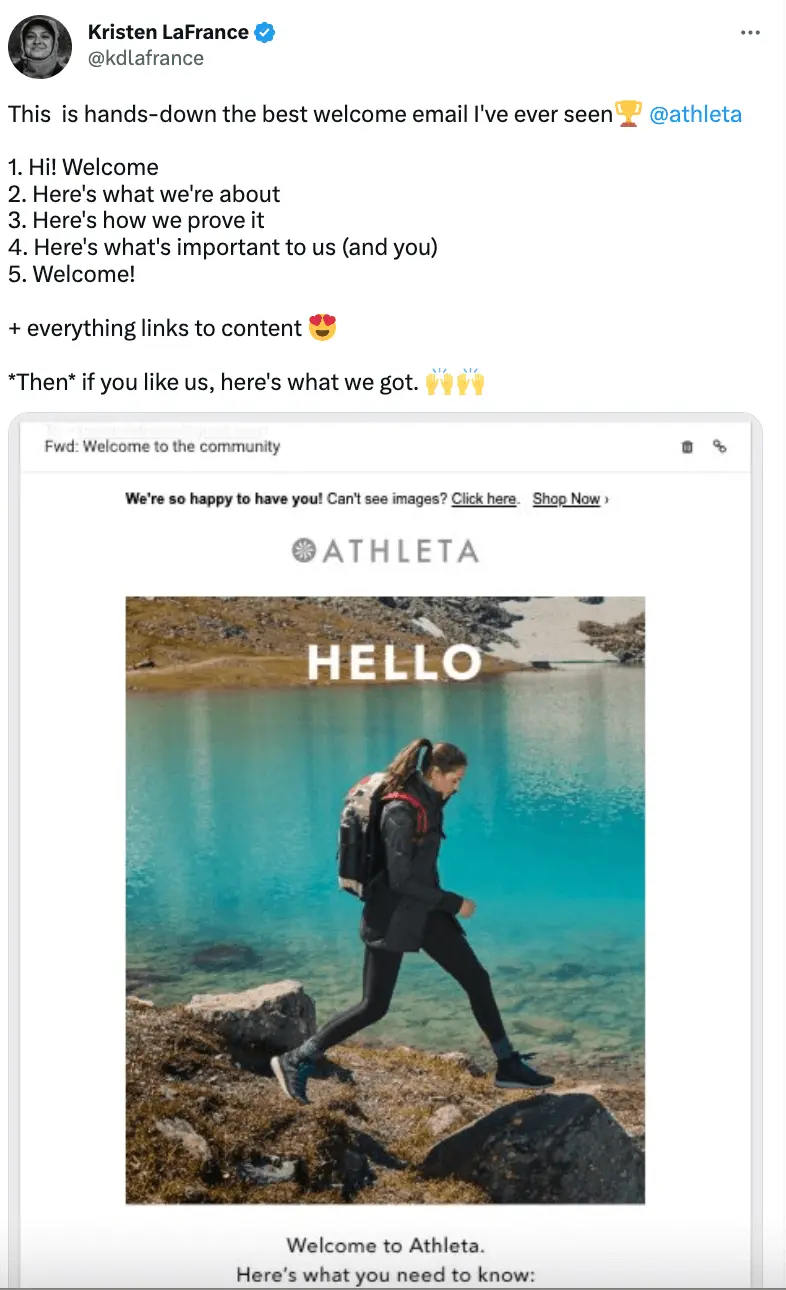
One thing to consider: adding video elements to your emails. According to Think with Google, more than half of shoppers say online videos help them decide which brand or product to buy.
Made In Cookware, for example, uses cooking videos—everyone’s favourite—to demonstrate the value of their products in their welcome series. When subscribers click into the video, they learn how to pan roast lamb from a high-end chef—but they also learn how to do it specifically with a Made In sauté pan. It’s a subtle product demo that doesn’t feel like one.
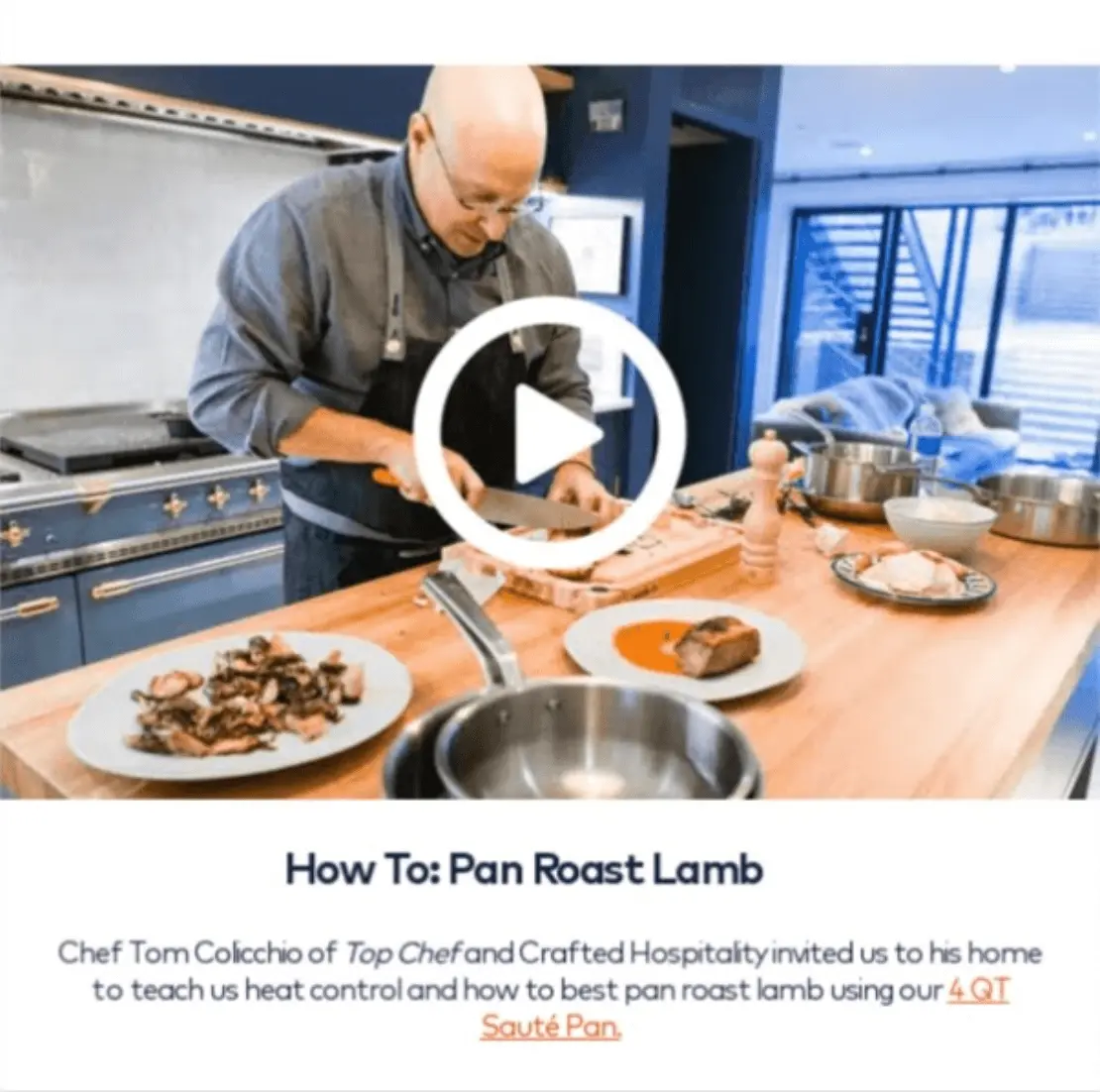
4. Convincing CTAs
Some of the best welcome email examples are the ones that inspire action. The action doesn’t need to focus on a purchase, although it can—and, at some point in your welcome series, it should. But a call to action (CTA) in an email can also prompt people to:
- Take a quiz.
- Explore your products.
- Initiate a download.
- Participate in a survey.
And remember: Don’t be afraid to place the CTA front and centre. Check out how Charlotte Stone Shoes places its CTA button in the header of their welcome email, with copy that’s impossible to ignore: “Shop.”
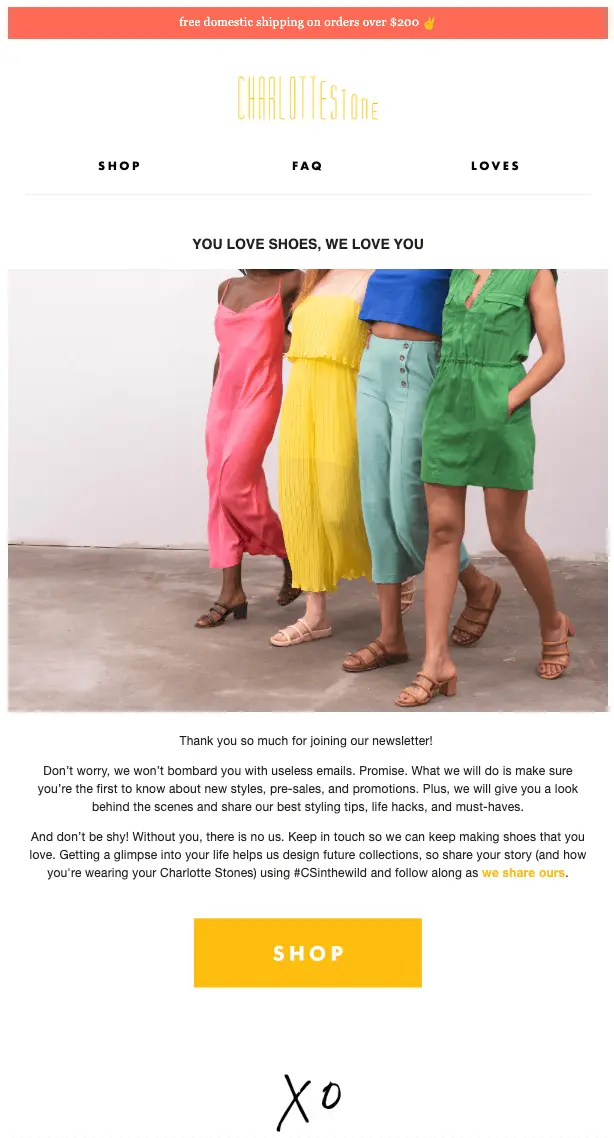
5. A clear value proposition
Your value proposition is the primary benefit your new customers enjoy when they’ve purchased one of your products. It’s the short and snappy answer to, “What’s in it for me?”
When someone subscribes to your list, they’ve participated in an exchange with your brand. They’ve done their part in handing over their email address, and now it’s time for you to do yours.
Oru Kayak fulfils their end of the bargain in their welcome email. The header copy, “Explore like never before,” is supported by a peaceful product image of their “beautiful origami kayaks designed for anything and anywhere.” The clear CTA, “Float On,” ties it all together to create a clear image of their value proposition.

6. Special offers
Special offers in welcome emails convert well. But that doesn’t mean you’re bound to the discount.
Ben Zettler, founder of Ben Zettler Digital, advises testing your offer first. “The ‘tried and true’ XYZ% off doesn’t have to be the way just because everyone else is doing it. Have you tried testing a gift with purchase? Or dollars off vs. a percentage off?”
Zettler also recommends experimenting with the structure and flow of your welcome series offer in these 3 ways:
- Use single-use discount codes generated in Klaviyo that are personalised to each recipient. Conversion rates are higher when an offer is specific to one person.
- Set a deadline for your incentive. Zettler recommends sending 3 messages that convey urgency over the course of 7 days.
- Offer a discount upgrade or extension for one day only for people who haven’t converted by the end of the week. Zettler recommends a “letter from the founder” as a way to make the last-ditch effort feel special.
How to build a welcome email flow
Now that you know the content components of a solid welcome email flow, here’s what you should know about volume, timing, and structure:
Optimise your email volume
There’s no one-size-fits-all for the amount of welcome emails in your series. But Ryan O’Connor, director of growth at SmartBug Media, likes to operate with this rule of thumb: “Send enough welcome emails to cover your average purchase cycle. If it takes customers, on average, 20 days from discovery to purchase—like for higher-priced products—a welcome series should reflect that to avoid losing sales.”
Remember, your welcome flow should fulfil two goals: educate people about your brand and nudge them toward a purchase. If your products require more education and sell for a higher price, send more emails as part of your welcome flow than a brand whose products are straightforward and inexpensive.
Time your welcome email series just right
Your first email should go out immediately after someone signs up for your list. After that, we recommend at least a day between emails so that you’re not slamming people’s inboxes.
But timing isn’t just about timing—it’s also about segmentation. When your email list starts to include thousands of people, things can get a little messy. To keep unsubscribe rates low and engagement rates up, you’ll need to “protect” people in your welcome flow from receiving all the other emails you send, too.
Eric Miller, director of lifecycle marketing of Tinuiti, puts it this way: “For email subscribers who are currently in the welcome series, suppress them from calendar sends. They aren’t ready for your full cadence. They’re still evaluating you and you haven’t earned their trust yet.”
Use double opt-in
When you launch your welcome series, email deliverability should be top of mind. All that work you’re putting in is for naught if your emails don’t make it to inboxes, after all.
Email deliverability is the rate at which your emails make it past spam filters and into people’s inboxes. Inbox providers like Gmail, Outlook, and iOS use algorithms to gauge the viability of an email based on factors like:
- Sender domain reputation
- Recipient engagement
- Email body content
Double opt-in goes a long way toward ensuring healthy deliverability rates. When someone subscribes to your list, use double opt-in by sending them an email that asks them to confirm their subscription—before you actually add them to your list.
Bonus: Your double opt-in email is a great way to collect more Customer-First Data™, too.
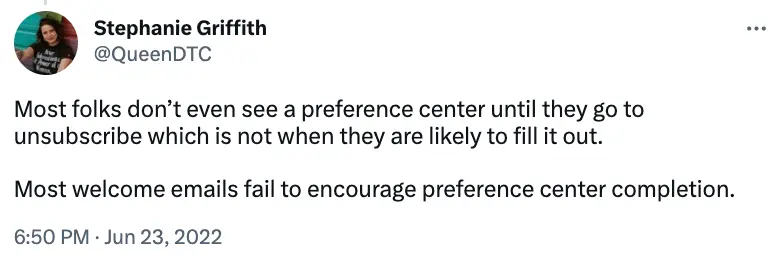
Include support contact details and unsubscribe links
In the EU, GDPR governs commercial email and gives people the right to opt out and unsubscribe from your email communications at any time. This is why all your emails need an obvious unsubscribe link—and it needs to be easy to unsubscribe.
Go the extra mile and include contact information for customer support, too. If you make it easy for a recipient to talk to a human being at your company, it could mean the difference between a sale and an unsubscribe.
How to automate your welcome emails
Sending a well-timed email series to thousands of recipients isn’t easy. But you don’t need to do it manually.
Email marketing automation is what allows brands to send personalised emails at scale, which essentially means you can make money from your email marketing strategy in your sleep.
With automation, you just need to set up your welcome email series once. Then, your email automation platform takes care of sending the emails to customers when they sign up. Here’s how to make this work for your welcome series:
Use Klaviyo email flows
When you’re building your welcome series, you won’t need to start from scratch. Klaviyo provides a pre-built welcome series flow that you can build on.
Setting up a welcome email series in Klaviyo involves 3 simple steps:
- Connect your email list.
- Define your triggers.
- Customise email content and style.
If you don’t want to use the pre-built welcome email flow, you can also design a welcome email flow from scratch. Klaviyo offers multiple welcome email templates for you to choose from.
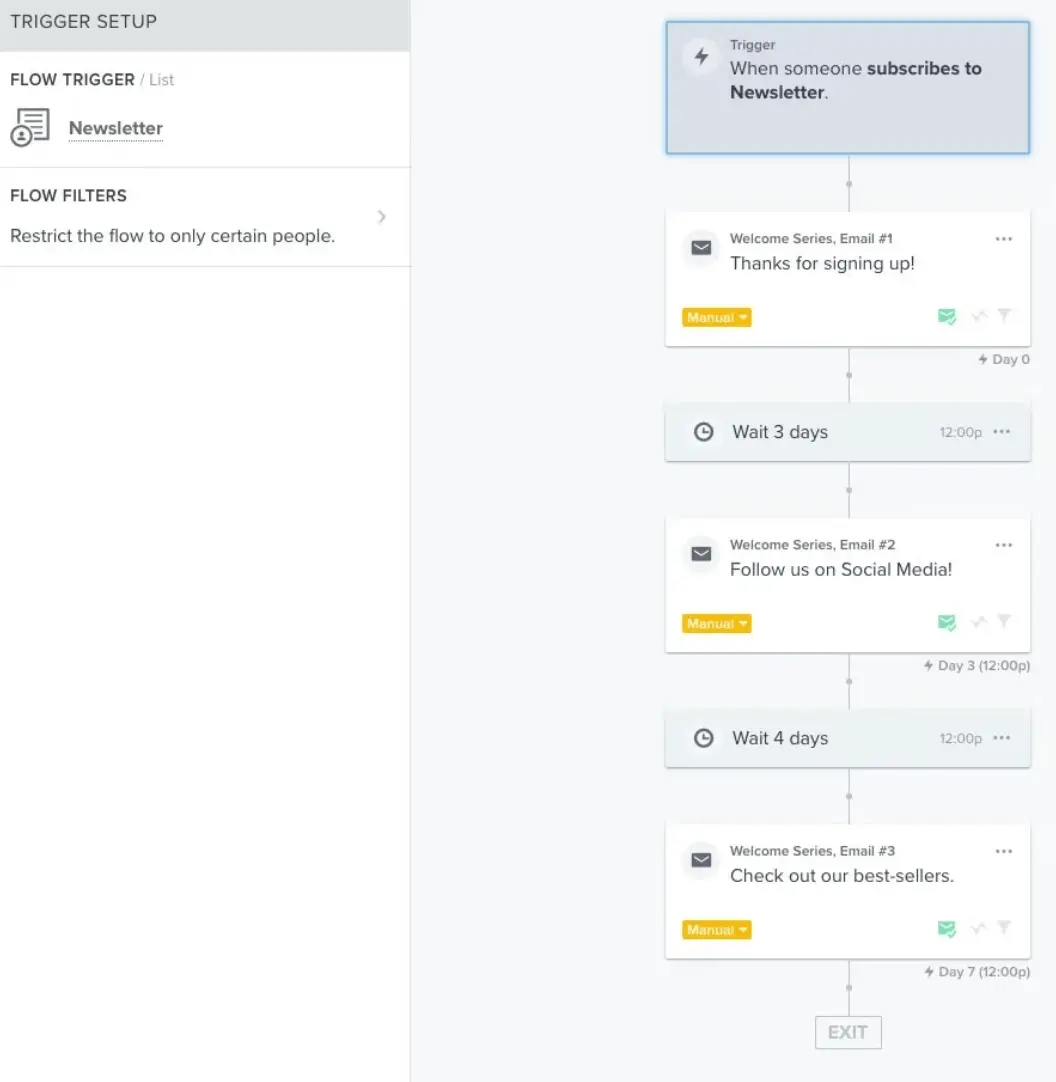
A/B test welcome emails to find the perfect one
You won’t know what’s working until you A/B test. And Klaviyo makes it easy to test your welcome email series.
A/B test various welcome email parameters with what’s called “conditional splits” in your welcome email flow.

A conditional split creates two branches in your welcome email flow, each creating a different experience based on a set of parameters. Test variables like:
- The target audience
- The timing of emails
- The frequency of emails
Here’s an example of two branches of a welcome email flow:
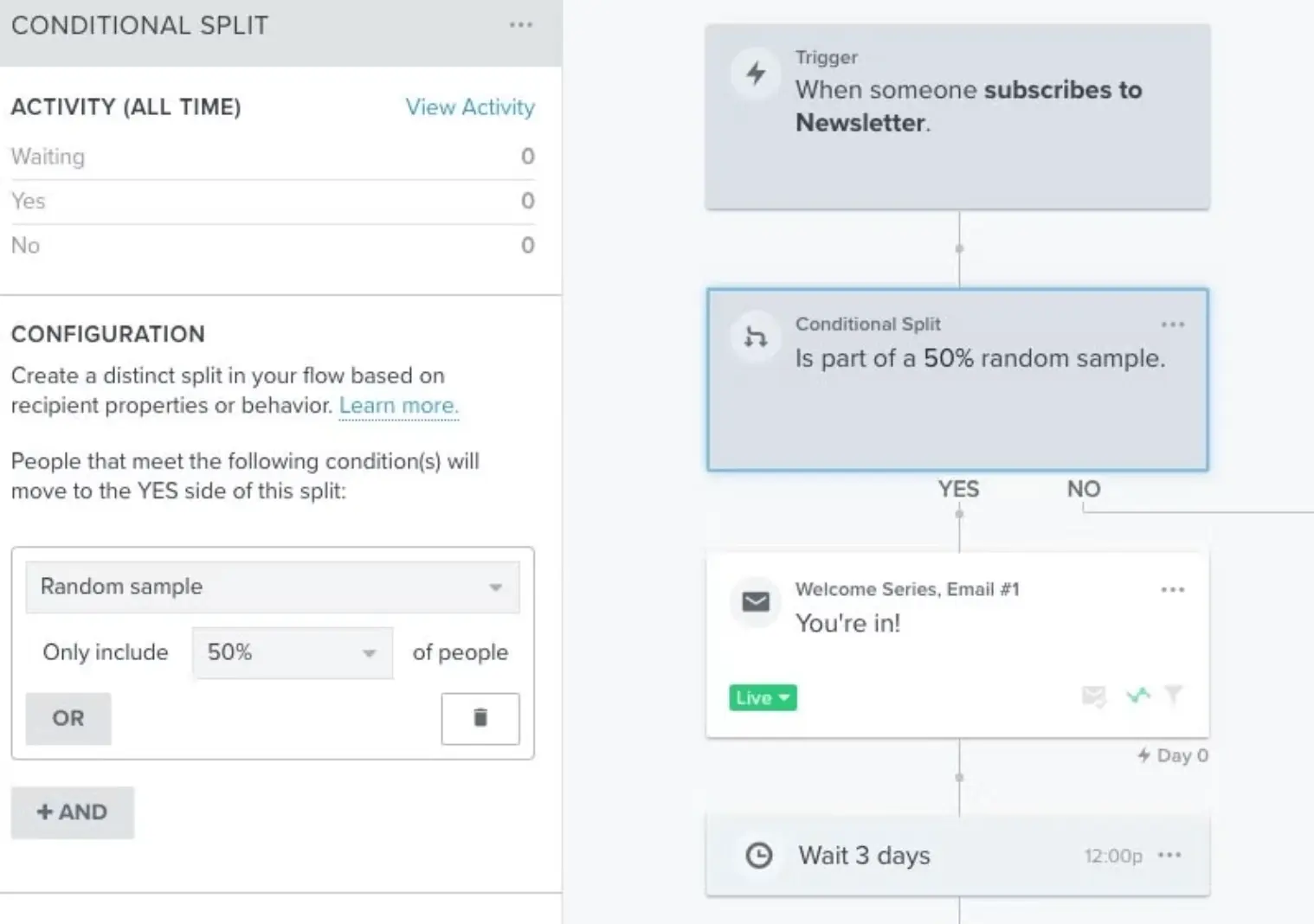
How to enhance your welcome email flow with data
Automation is only a standout when it’s fused with relevant, targeted personalisation. That means collecting data on your subscribers—which they hand over voluntarily—so you can send them emails that are more relevant for them.
Here’s how:
Personalise your welcome emails with customer data
Data you gather directly from your subscribers and customers has two components: first-party data and zero-party data.
First-party data is based on directly observable behaviour like purchasing trends, website activity, email and SMS engagement, and customer service interactions.
Then there’s zero-party data, which the customer inputs themselves into a form. This includes things like:
- Birthday
- Product preferences
- Interests
- Demographic information
For example, Wilkinson Sword asks people what types of products they’re interested in when they sign up to email marketing. Then, they send a personalised welcome email to new subscribers that matches their preferences—this simple segmentation in the welcome series results in a 20x higher conversion rate than average.
Another valuable piece of zero-party data is a phone number for SMS communication. If your brand earns a presence in someone’s text message inbox, your relationship with that subscriber has reached the next level.
So how do you get the phone number?
“For those not subscribed to SMS, offer something interesting that they can only receive by text,” suggests Lisa Oberst, director of email marketing for Fuel Made. “Let’s say you sell bicycle bells and the main selling point is the beautiful, long-lasting ring of the bell. You could get subscribers to sign up to SMS and receive a sound preview.”
Track your welcome email flow performance
You can’t improve what you don’t measure. As you refine your welcome series through A/B testing, watch your email performance like a hawk. That means keeping track of the following metrics:
- Click-through rate (CTR): the percentage of recipients who click on a link within your welcome flow
- Conversion rate: the percentage of recipients who take action after they click your welcome flow
- Revenue per recipient (RPR): how much money every welcome email recipient is bringing in
- Deliverability rates: the percentage of welcome flow emails that makes it to your recipients’ inboxes
- Unsubscribe rate: the percentage of people who receive your welcome flow and then unsubscribe from your list
- List growth rate: the rate at which you’re acquiring new subscribers to your list
- Return on investment (ROI): the financial return from your welcome flow compared to the money you’ve spent
With Klaviyo reporting, you can track these metrics at a glance on your dashboard.
Measure your brand against welcome email benchmarks
Curious about what “good performance” looks like for the typical welcome series? According to the latest Klaviyo benchmarks, welcome series emails earn high open rates, conversion rates, and revenue-per-recipient, which makes the automation one of the most effective series of emails you can send.
Here’s what to expect:
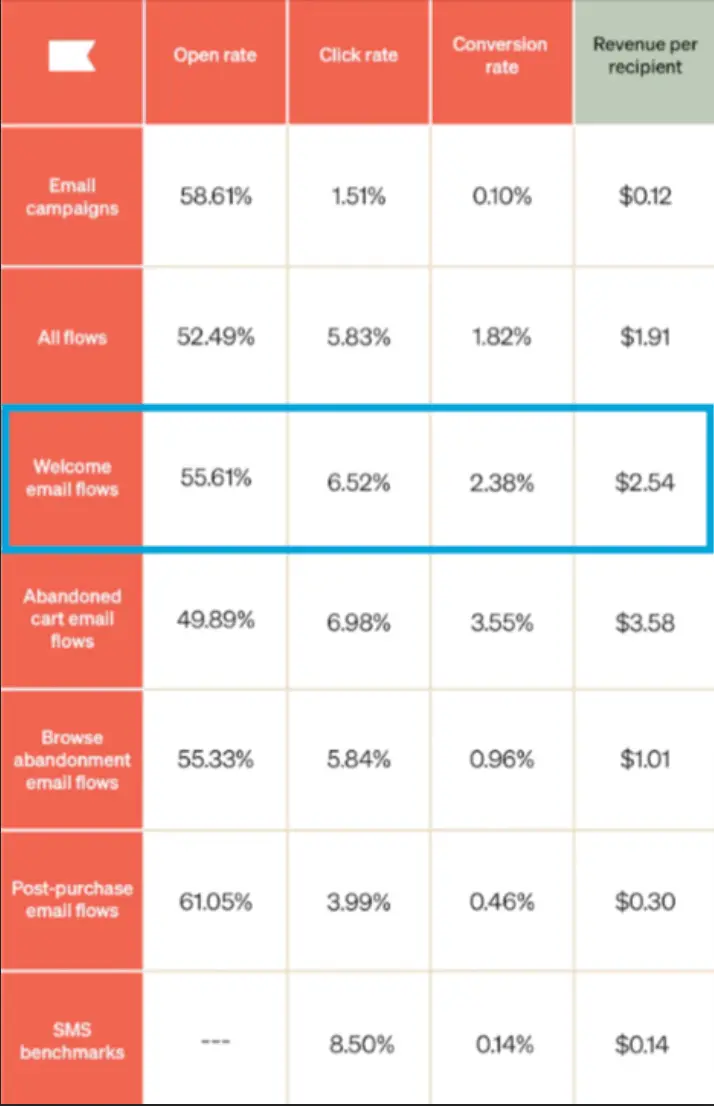
Benchmarks may vary based on industry, however, so check out your category to see what to expect from your welcome email series.
Welcome email FAQs
How to write a good welcome email subject line?
Write a good welcome email subject line by using the recipient’s first name, keeping it clear and brief, and evoking a sense of curiosity that encourages people to open your email just to find out what’s inside.
How many emails should be included in a welcome email sequence?
The number of emails in your welcome email sequence depends on the length of your average purchase cycle. If it takes potential customers, on average 20 days, from discovery to first purchase, your welcome flow should reflect that to avoid losing sales.
What is the business impact of a welcome email?
The business impact of a welcome email is, on average, $2.54 per recipient. Welcome emails also earn a high average open rate of 55.61% across all industries, in addition to a conversion rate of 2.38%.



